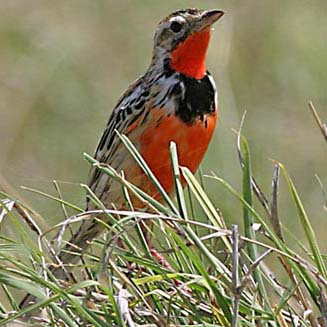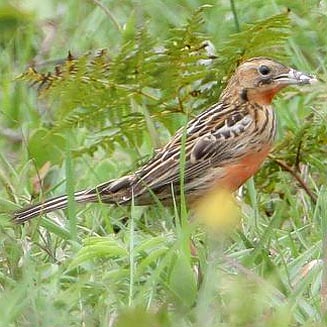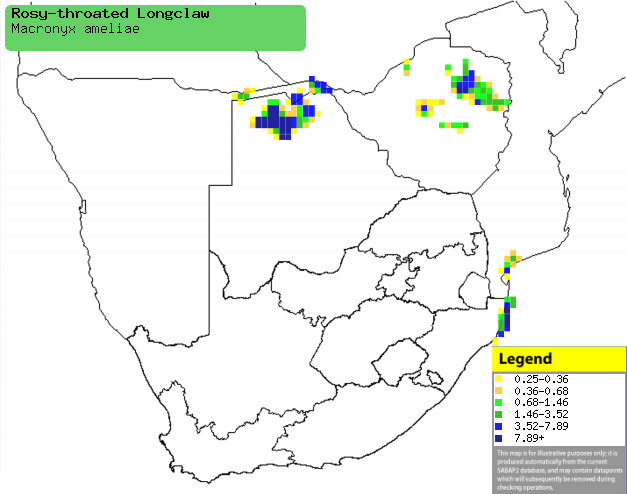|
Macronyx ameliae (Rosy-throated
longclaw, Pink-throated longclaw)
Rooskeelkalkoentjie [Afrikaans]; Roodkeel-langklauw
[Dutch]; Sentinelle à gorge rose [French]; Rotkehlgroßsporn,
Karmesinpieper [German]; Unha-longa-vermelho [Portuguese]
Life
> Eukaryotes >
Opisthokonta
> Metazoa (animals) >
Bilateria >
Deuterostomia > Chordata >
Craniata > Vertebrata (vertebrates) > Gnathostomata (jawed
vertebrates) > Teleostomi (teleost fish) > Osteichthyes (bony fish) > Class:
Sarcopterygii (lobe-finned
fish) > Stegocephalia (terrestrial
vertebrates) > Tetrapoda
(four-legged vertebrates) > Reptiliomorpha > Amniota >
Reptilia (reptiles) >
Romeriida > Diapsida > Archosauromorpha > Archosauria >
Dinosauria
(dinosaurs) > Saurischia > Theropoda (bipedal predatory dinosaurs) >
Coelurosauria > Maniraptora > Aves
(birds) > Order: Passeriformes
> Family: Motacillidae > Genus: Macronyx
 |
 |
|
Rosy-throated longclaw male, Tanzania. [photo
Martin Goodey
©] |
Rosy-throated longclaw female, Ozambeni, South
Africa. [photo Trevor Hardaker ©] |
Distribution and habitat
Although it occurs separately in Kenya the bulk of its
population is distributed from Angola, Zambia and Malawi to southern Africa.
Here it is uncommon and localised in northern Botswana and the Caprivi Strip
(Namibia), north-central Zimbabwe and southern Mozambique and KwaZulu-Natal,
generally preferring damp or waterlogged short grassland and edges of lakes or
vleis.
|
 |
|
Distribution of Rosy-throated longclaw in southern Africa,
based on statistical smoothing of the records from first SA Bird Atlas
Project (©
Animal Demography unit, University of
Cape Town; smoothing by Birgit Erni and Francesca Little). Colours range
from dark blue (most common) through to yellow (least common).
See here for the latest distribution
from the SABAP2. |
Food
It mainly eats small insects, doing most of its foraging on
the ground, occasionally hawking prey aerially. The following food items have been recorded
in its diet:
Breeding
- Monogamous, territorial solitary nester, breeding in open grassland next
to shallow wetlands; due to the absence of trees, males sing on mounds and
low bushes. Males also perform an aerial display in which they fly around
just above the grass with feet dangling.
- The nest is built solely by the female, consisting of a deep open cup of
coarse grass stems lined with rootlets, typically concealed between grass
tussocks on the ground.
- Egg-laying season is from October-April, peaking from December-February.
- It lays 2-3 eggs, which are incubated solely by the female for about
13-14 days.
- The chicks are fed by both parents, leaving the nest after about 16
days.
Threats
Not threatened globally, but Near-threatened in
South Africa, largely due too overgrazing of subtropical pans and floodplain
grassland, but drainage of wetlands and agriculture are also cause for concern.
References
-
Hockey PAR, Dean WRJ and Ryan PG 2005. Roberts
- Birds of southern Africa, VIIth ed. The Trustees of the John Voelcker
Bird Book Fund, Cape Town.
|
